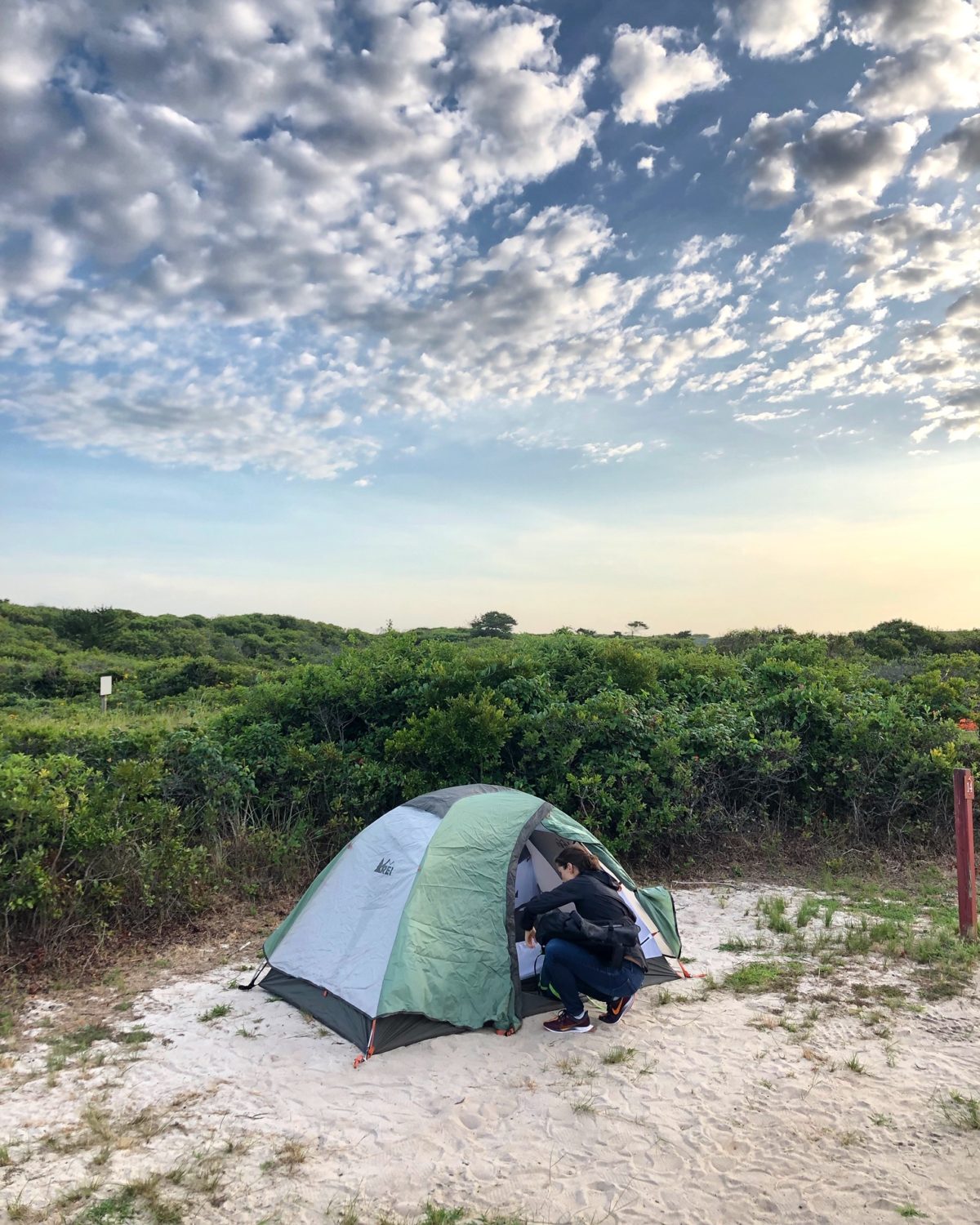Last summer we took a short camping trip to the Fire Island National Seashore. The island is fairly easy to access from NYC and it makes for a nice weekend escape. It is filled with diverse animal and plant life, and we had some great views from our campsite. It was all very idyllic until you added in the mosquitoes. There were a LOT of mosquitoes that we had to contend with and it made the camping slightly less than pleasurable. Either way, it is a beautiful island to visit and worth a quick trip.
The National Park Service established the Fire Island National Seashore in 1964. The park covers 26 miles of the 32 mile long island. There are also 17 commercial communities on the island, one of which is Davis Park, within walking distance to the campground. The protected area of 19,579 acres holds bay islands, sand flats and wetlands.
Trip Planning: Before

Since the island is so popular, it is important to book your accommodation early. If you plan to camp, you’ll want to make a reservation at LoveFins. LoveFins has both camping and glamping options. The National Park Service also offers backcountry camping, which you will need an overnight permit for.
Aside from those options, you can also stay at a rented house in other parts of the island outside of the protected area.
Getting to Fire Island
There are a number of ways that you can get to Fire Island. We took the Long Island Railroad from Penn Station to the Patchogue Station. From there you can take a few block walk over to the Patchogue-Watch Hill Ferry, which is operated by the National Park Service. The ferry leaves regularly in summer months, but you should check the schedule before heading out. If you drive, there are parking spots available at the ferry terminal. You can also access the Davis Park Ferry nearby, which will require you to walk about 1 mile from the ferry dock to the campground.

After exiting the ferry on Fire Island, you will see wetlands and sand dunes spreading out before you. There is no fee to enter the national seashore and you will only need to pay for your camping fees. Please note that there are no paved roads within Fire Island National Seashore. This means once you get off the ferry, anywhere you visit will be by foot. During our stay we explored the wetland area on our run, but we mainly stayed close to the campsite and the beach.

Camping On Fire Island
During our stay we camped at Watch Hill Campground, which is part of the Fire Island National Seashore. The campground is only a quarter mile from the ferry marina, making it easily accessible by foot. LovFins, an authorized concessioner of the National Park Service, runs the campground, glamping and the marina. In total the campground has 23 campsites, 1 group site and 4 platform furnished tent glamping options. Check in was easy and we were able to go directly to our site.
For camping on the island, you’ll need a rain fly in case you get rain during your stay (we did). And since the sites are on soft sand, you’ll need long metal stakes for the tent. The weather can be a bit variable with cooler nights and hot days in summer. I’d recommend bringing both warm and cool weather clothing, as well as adequate mosquito repellant.
The campground is located close to the marina, so there are a decent amount of amenities nearby, albeit overpriced. There is a restaurant, bar and small convenience store. I recommend bringing food and gear with you instead of purchasing when you are on the island.

Animal Friends & Mosquitoes!
We saw quite a few animals while we were camping, such as lots of little bunnies in the tall grass beyond our campsite. They were skittish, but ever-present in the dunes nearby. Additionally, there were a number of deer seemingly unbothered by humans, which was a bit worrisome. One deer even sprawled out in various campsites and wandered around looking for food. This is definitely not ideal animal behavior, as it shows the dependency of the animals on humans as a food source.
One huge challenge we had while camping were the mosquitoes. Since the campground is located near the swampy wetlands, there are so many mosquitoes around. Yikes! It was especially bad in the mornings and evenings. Whenever we left our tent we were instantly swarmed by mosquitoes that landed on any area that was not covered in repellant or clothing.
This made our camping experience a bit less than ideal. We sprayed ourselves, but we weren’t prepared for such aggressive mosquitoes. In fact, the park service recommends visiting in spring or fall to avoid large amounts of mosquitoes or ticks. If you do go in summer, make sure to pack accordingly with light long sleeves, repellent and citronella.
Getting a Run in (with no roads available)

Fire Island has no roads in the section of the island where we were staying. Everything is either soft sand trails or narrow wooden boardwalks. While this makes going on a run difficult, we found a way to get a run in and be creative. We did loops on the boardwalks and ran over to the nearby Davis Park community. Thankfully the wetlands area was fairly empty in the morning and it allowed us space for the run. One benefit of the run was that the mosquitoes didn’t bother us. See the Strava outline of our run below.


Beach Time at the Fire Island Seashore

After finishing our run, we headed to the beach for some relaxation. The beach was just over the dune from where our campsite was, so it was an easy walk away. The beach had soft sand and grassy covered dunes as far as the eye could see. A plus was that there weren’t too many people there and we got to enjoy our books on the beach. And thankfully there weren’t any mosquitoes in the beach area.

All in all, it was a solid trip to Fire Island. While it was tough to camp with so many mosquitoes, I still enjoyed the views and seeing the island. I imagine it would be a great trip to take in the spring or fall when there are less mosquitoes. I hope to someday return, maybe next time in a rented house.
Check out some of my other travel and camping experiences on my destinations page. And if you are interested in running, check out my travel running page.

This is great Lucy! I’m down for camping but I know Zak wont be able to hang. Glamping will be more his speed and it will be fun to try. I’ve never been to Fire Island!!!!
Thanks Jess! That sounds like a great idea and you should definitely check it out!